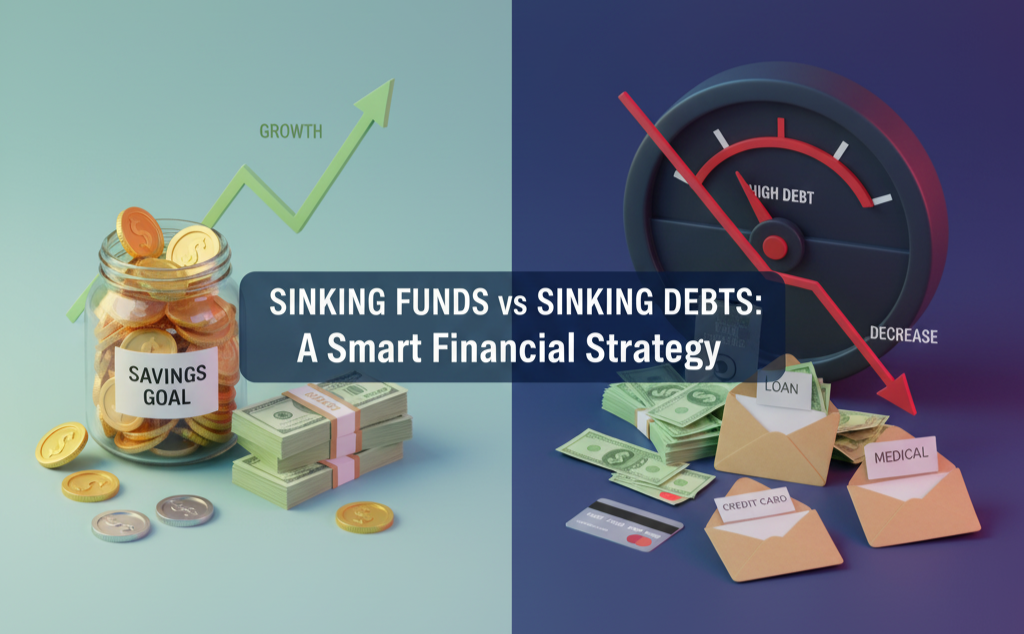Sinking Funds vs Sinking Debts: A Smart Financial Strategy for 2025

Managing personal finances feels hard for many people today. Prices keep rising and unexpected costs appear without warning. Because of this, many people search for simple methods that offer more control. One method that works well is using sinking funds. Another helpful method is the sinking debt strategy. Both ideas support better money management and long-term financial peace.
In this blog, you will learn how these two approaches work. You will also see how they support daily budgeting and reduce stress.
What Is a Sinking Fund?
A sinking fund is money saved for a future expense. It is not an emergency fund. It also differs from a normal savings account. Instead, it focuses on one specific purpose. For example, you might save for a trip, a laptop, or car insurance.
Because each fund has one goal, tracking progress becomes very easy. This improves clarity and supports smart expense tracking every month.
Why Sinking Funds Matter in 2025
Living costs are rising everywhere. Many people use credit cards for planned expenses. This often increases debt and interest. However, sinking funds prevent this problem.
First, they spread a large cost into smaller monthly deposits. This removes pressure from your monthly budgeting plan. Second, they offer emotional comfort because you always know the money is ready.
Furthermore, sinking funds teach discipline. You learn to prepare for future costs instead of reacting at the last minute.
Examples of Common Sinking Funds
People use sinking funds for many reasons. Here are popular examples:
- Yearly vehicle maintenance
- Home repairs or appliance upgrades
- Travel plans or festivals
- Medical checkups
- School fees
- Big gadget upgrades
These categories help people practice consistent money management. They also reduce the sudden shock of big expenses.
Introducing the “Sinking Debt” Strategy
The sinking debt strategy applies the same idea to debt repayment. Instead of paying only the minimum amount, you create a dedicated fund for debt. You add a small amount to this fund every month. Once the fund grows, you make a larger payment toward your debt.
This method offers several benefits. First, it improves your repayment plan. Second, it creates a clear structure. Third, it helps you avoid emotional spending because your debt goal becomes very visible.
Why Sinking Debt Works Better Than Minimum Payments
Minimum payments usually keep you in debt for a long time. Interest builds and progress feels slow. However, sinking debt payments push your balance down faster.
You can also adjust your deposit amount whenever your income changes. This makes the method flexible and realistic. Most importantly, you gain emotional control. You always know you are working toward a clear target.
How Sinking Funds Support Better Budgeting
Sinking funds work well with simple budgeting methods. First, you list your monthly fixed expenses. Then you add small sinking fund deposits. Even a small amount helps.
Because you plan ahead, you avoid using credit cards for planned costs. This lowers financial stress. It also improves your long-term habits. Every deposit reminds you that slow progress still counts.
How to Start Your First Sinking Fund
Starting a sinking fund is easy. Follow these steps:
- Choose one clear goal.
- Decide the total amount you need.
- Pick a deadline.
- Divide the total by the number of months.
- Add that amount to your plan each month.
Although this process is simple, many people never start. However, once you begin, the habit grows naturally.
How to Build a Sinking Debt Plan
Here is a straightforward approach:
- Write down your total debt.
- Check the interest rates.
- Decide your target timeline.
- Set monthly contributions to your sinking debt fund.
- Make a larger payment after every few months.
This strategy helps you stay consistent. It also gives you a stronger sense of progress.
Real-Life Scenarios Where These Methods Help
1. A Professional Planning a Vacation
This person creates a travel sinking fund. They add a small amount every month. When the trip arrives, everything feels easy.
2. A Freelancer With Irregular Income
This person saves for slow months and yearly fees. Sinking funds protect them during income gaps.
3. Someone Tackling Credit Card Debt
This person sets a sinking debt target. Every few months, they make a larger payment. Soon, the card balance drops faster.
These scenarios show how flexible the methods are. They support different income types and different financial goals.
Common Mistakes and How to Avoid Them
People sometimes make mistakes while using sinking funds or sinking debt. Here are simple fixes:
- Do not create too many funds.
- Do not ignore small deposits.
- Do not skip a review at the end of each month.
- Do not mix regular spending with sinking fund savings.
With small improvements, each fund becomes stronger and easier to maintain.
Final Thoughts
Sinking funds and sinking debt strategies are simple, but they create powerful financial discipline. They help you understand your spending, avoid unplanned debt, and make smarter choices. They also support clear expense tracking and better money management every month.
If you want an easy way to start, you can explore simple tools that help you track your habits. Many people use apps like DollarBook to stay consistent without pressure.
